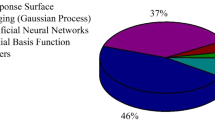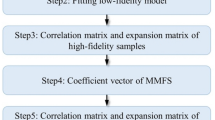Abstract
In computational simulation, a high-fidelity (HF) model is generally more accurate than a low-fidelity (LF) model, while the latter is generally more computationally efficient than the former. To take advantages of both HF and LF models, a multi-fidelity surrogate model based on radial basis function (MFS-RBF) is developed in this paper by combining HF and LF models. To determine the scaling factor between HF and LF models, a correlation matrix is augmented by further integrating LF responses. The scaling factor and relevant basis function weights are then calculated by employing corresponding HF responses. MFS-RBF is compared with Co-Kriging model, multi-fidelity surrogate based on linear regression (LR-MFS) model, CoRBF model, and three single-fidelity surrogates. The impact of key factors, such as the cost ratio of LF to HF models and different combinations of HF and LF samples, is also investigated. The results show that (i) MFS-RBF presents a better accuracy and robustness than the three benchmark MFS models and single-fidelity surrogates in about 90% cases of this paper; (ii) MFS-RBF is less sensitive to the correlation between HF and LF models than the three MFS models; (iii) by fixing the total computational cost, the cost ratio of LF to HF models is suggested to be less than 0.2, and 10–80% of the total cost should be used for LF samples; (iv) the MFS-RBF model is able to save an average of 50 to 70% computational cost if HF and LF models are highly correlated.

















Similar content being viewed by others
References
Acar E (2010) Various approaches for constructing an ensemble of metamodels using local measures. Struct Multidiscip Optim 42(6):879–896
Acar E, Rais-Rohani M (2009) Ensemble of metamodels with optimized weight factors. Struct Multidiscip Optim 37(3):279–294
Cai X, Qiu H, Gao L, Shao X (2017a) Metamodeling for high dimensional design problems by multi-fidelity simulations. Struct Multidiscip Optim 56(1):151–166
Cai X, Qiu H, Gao L, Wei L, Shao X (2017b) Adaptive radial-basis-function-based multifidelity metamodeling for expensive black-box problems. AIAA J 55(7):1–13
Durantin C, Rouxel J, Désidéri JA, Glière A (2017) Multifidelity surrogate modeling based on radial basis functions. Struct Multidiscip Optim 56(5):1061–1075
Forrester AIJ, Sóbester A, Keane AJ (2007) Multi-fidelity optimization via surrogate modelling. Proceedings of the royal society a: mathematical, physical and engineering sciences 463(2088):3251–3269
Forrester AIJ, Sóbester A, Keane AJ (2008) Engineering design via surrogate modelling: a practical guide. DBLP, Trier
Goel T, Haftka RT, Wei S, Queipo NV (2007) Ensemble of surrogates. Struct Multidiscip Optim 33(3):199–216
Gutmann HM (2001) A radial basis function method for global optimization. J Glob Optim 19(3):201–227
Han ZH, Görtz S, Zimmermann R (2013) Improving variable-fidelity surrogate modeling via gradient-enhanced kriging and a generalized hybrid bridge function. Aerosp Sci Technol 25(1):177–189
Jones DR (2001) A taxonomy of global optimization methods based on response surfaces. J Glob Optim 21(4):345–383
Kennedy MC, O'Hagan A (2000) Predicting the output from a complex computer code when fast approximations are available. Biometrika 87(1):1–13
Kushner HJ (1964) A new method of locating the maximum point of an arbitrary multipeak curve in the presence of noise. J Basic Eng 86(1): 97–106
Li X, Gao W, Gu L, Gong C, Jing Z, Su H (2017) A cooperative radial basis function method for variable-fidelity surrogate modeling. Struct Multidiscip Optim 56(5):1077–1092
Liu H, Xu S, Wang X, Meng J, Yang S (2016) Optimal weighted pointwise ensemble of radial basis functions with different basis functions. AIAA J 54(10):1–17
Matheron G (1963) Principles of geostatistics. Econ Geol 58(8):1246–1266
Myers RH, Montgomery DC, Anderson-Cook, CM (2016) Response surface methodology: process and product optimization using designed experiments. J. Wiley & Sons
Petersen KB, Pedersen MS (2008) The matrix cookbook. Technical University of Denmark 7(15):510
Sacks J, Welch WJ, Mitchell TJ, Wynn HP (1989) Design and analysis of computer experiments. Stat Sci 4(4):409–423
Schonlau M, Welch WJ, Jones DR (1998) Global versus local search in constrained optimization of computer models. Lecture Notes-Monograph Series 34:11–25
Smola AJ, Schölkopf B (2004) A tutorial on support vector regression. Stat Comp 14(3): 199–222
Sun G, Li G, Gong Z, He G, Li Q (2011) Radial basis functional model for multi-objective sheet metal forming optimization. Eng Optim 43(12):1351–1366
Toal DJJ (2015) Some considerations regarding the use of multi-fidelity Kriging in the construction of surrogate models. Struct Multidiscip Optim 51(6): 1223–1245
Tyan M, Nguyen NV, Lee JW (2015) Improving variable-fidelity modelling by exploring global design space and radial basis function networks for aerofoil design. Eng Optim 47(7):885–908
Viana FAC, Simpson TW, Balabanov V, Toropov V (2014) Special section on multidisciplinary design optimization: metamodeling in multidisciplinary design optimization: how far have we really come? AIAA J 52(4):670–690
Wang GG, Shan S (2006) Review of metamodeling techniques in support of engineering design optimization. ASME 2006 international design engineering technical conferences and computers and information in engineering conference. Am Soc Mech Eng 129(4):415–426
Zerpa LE, Queipo NV, Pintos S, Salager JL (2005) An optimization methodology of alkaline–surfactant–polymer flooding processes using field scale numerical simulation and multiple surrogates. J Pet Sci Eng 47(3):197–208
Zhang Y, Kim NH, Park C, Haftka RT (2018) Multifidelity surrogate based on single linear regression. AIAA Journal, 56(12) 4944–4952
Zhou Q, Jiang P, Shao X, Hu J, Cao L, Wan L (2017a) A variable fidelity information fusion method based on radial basis function. Adv Eng Inform 32(C):26–39
Zhou Q, Wang Y, Choi SK, Jiang P, Shao X, Hu J (2017b) A sequential multi-fidelity metamodeling approach for data regression. Knowl-Based Syst 134:199–212
Funding
The research is supported by the National Natural Science Foundation of China (Grant No. 51505061 and Grant U1608256).
Author information
Authors and Affiliations
Corresponding author
Ethics declarations
Conflict of interest statement
The authors declare that they have no conflict of interest.
Replication of results
The main codes and raw data corresponding to each figure are submitted as supplementary materials.
Additional information
Responsible Editor: Raphael Haftka
Publisher’s note
Springer Nature remains neutral with regard to jurisdictional claims in published maps and institutional affiliations.
Rights and permissions
About this article
Cite this article
Song, X., Lv, L., Sun, W. et al. A radial basis function-based multi-fidelity surrogate model: exploring correlation between high-fidelity and low-fidelity models. Struct Multidisc Optim 60, 965–981 (2019). https://doi.org/10.1007/s00158-019-02248-0
Received:
Revised:
Accepted:
Published:
Issue Date:
DOI: https://doi.org/10.1007/s00158-019-02248-0




